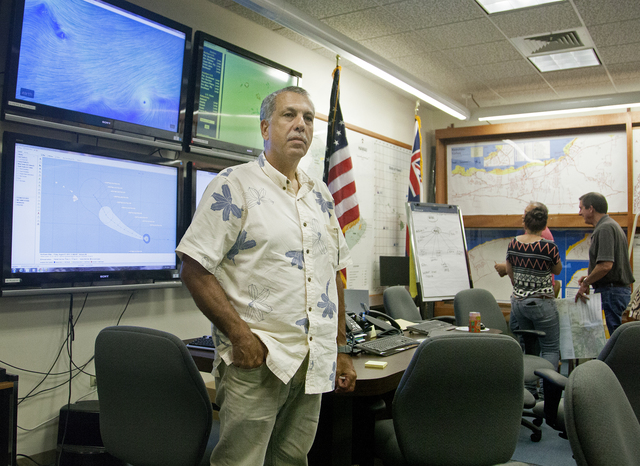One year after Tropical Storm Iselle made landfall on Hawaii Island, its lasting impact may be one of better preparedness in the event of future storms. ADVERTISING One year after Tropical Storm Iselle made landfall on Hawaii Island, its lasting
One year after Tropical Storm Iselle made landfall on Hawaii Island, its lasting impact may be one of better preparedness in the event of future storms.
Forecasters have said Hawaii can expect a busier hurricane season this year, and that forecast appears, so far, to be holding up. With the remnants of Tropical Storm Guillermo fading after passing close to the Big Island this weekend and the newly classified Hurricane Hilda churning this way, Hawaii County Civil Defense is maintaining a close watch on weather systems across the Pacific.
Meanwhile, Civil Defense staffers are applying important lessons learned from destructive Iselle, according to Director Darryl Oliveira.
“For us, pre-impact, one of the changes (we wanted to make) was better communication,” he said Friday. “If you noticed with Guillermo, and you’ll start to hear this afternoon and going into the weekend, more frequent and earlier public messaging.”
During and after Iselle, as well as during the protracted approach of the June 27 lava flow in lower Puna, Oliveira’s voice became a fixture on Big Isle airwaves as he provided updates and timely information for residents. And this hurricane season he has opted to continue that tradition as storm systems build.
“Before we have a watch or warning, we’re letting people know that the systems are being tracked and monitored,” he said. “Early, timely, regular, routine messaging for the public.”
The agency also has worked to build partnerships with the many community associations across the island, so that they may serve as additional sources of information as situations develop.
“We have been sending information out to the community association contacts, like their boards of directors or board members, and from there they use their own internal or informal communication, like telephone trees, to push it out,” Oliveira said. “We’re trying to saturate the community with consistent messaging. And that has worked out well.”
Oliveira said he also is working to build better communication within Civil Defense and with its partner agencies. As an example, he said that in the days following Iselle’s arrival, he was surprised to learn that Community Emergency Response Teams had not gone door to door in Kapoho Vacationland to warn residents of the approaching storm. Many homes there were damaged severely and a few were destroyed by the heavy storm surge.
“Many people there were disappointed there was no door-to-door notification,” he said. “It was important for us to hear that.”
Another area where community associations are being enlisted is in the dissemination of food and supplies. Shortly after Iselle hit, the county set up a station at Pahoa High School where area residents could come to receive food, water and ice. But many people said they left empty-handed after traveling in some cases a long distance and then spending hours in the lines.
A donation of 25 shipping containers by Matson has allowed the county to supply community associations with places to store emergency supplies, and in the event of a disaster they will serve as rallying points for their communities.
“It will help to meet the needs of the population where the population needs it,” Oliveira said. “It will make things more accessible.”
Community associations also have helped to map out their neighborhoods, keeping track of where elderly or infirmed individuals live so that responders know how to get to them and what their needs are.
By and large, the county’s initial response plans worked well, he added, but in the days and weeks after Iselle hit, the ongoing recovery plan showed room for “tremendous improvement.”
With dozens of government and nonprofit agencies involved in the recovery, there was a need for a more centralized system of surveying affected residents to get them the help they needed. Often, people who were hungry, tired and frustrated were being asked again and again what they needed without seeing much action, he said.
“They probably got surveyed so many times, by the end they were like, ‘When is help actually coming?’” Oliveira said. “People were just asking the same questions over and over.”
As a result, Civil Defense worked with the agencies to develop a standardized form for residents to fill out, which would then be passed along to the appropriate case managers to follow up with the residents and ensure that they were being helped in a timely and efficient manner.
“During this past exercise period in June, we started to work on the recovery side of things. Working with community associations, various partners at nonprofit associations, finding out what services they provide, what’s their strong suit and what’s their capacity,” he said.
Looking back at Iselle, Oliveira said there were plenty of things that went right with the response and recovery, while admitting that there also was plenty of room for improvement. As he spoke, a wall of monitors behind him displayed a multitude of forecasts and computer models of the large mass of swirling wind and rain known as Hurricane Hilda.
As of 6 p.m. Saturday, the Category 4 storm was 800 miles east-southeast of the Big Island and traveling west at 15 mph through an area of low wind shear and warm sea surface temperatures. Hurricane force winds extended out 25 miles and tropical storm force winds reach out 125 miles.
“We’ll keep watching it,” he said.
Email Colin M. Stewart at cstewart@hawaiitribune-herald.com.



